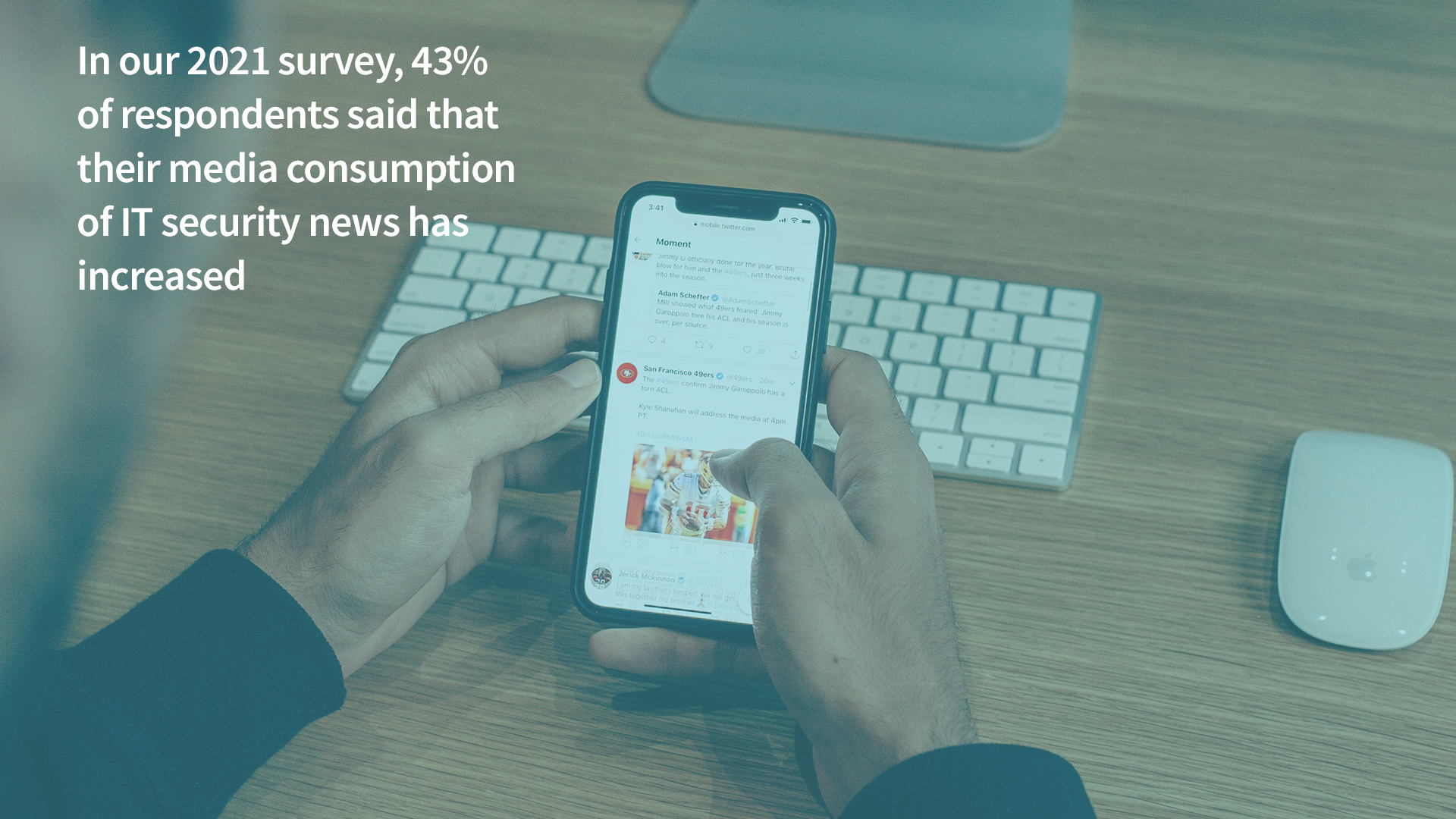Our annual media consumption report findings are in! Over the past few years, we’ve continued to track IT security professionals’ changing media consumption habits to identify common themes and emerging trends.
Unsurprisingly, the past couple of years has presented a huge shift in how, when and why people use certain media channels. Covid-19 introduced lockdowns and a mass move to working from home, putting pressure on companies to upgrade their security measures to support remote workers. Remote working has also led to an increase in online media consumption and a move to virtual events and broadcast channels.
Covid-19 and remote working
Covid-19 forced many companies to move to remote working, almost overnight. As a result, security has been a big concern for employers of all sizes, across industries. Naturally, cyber criminals have seized the opportunity of mass remote working to target businesses and individuals with new and advanced methods of attack.
This makes the timing of our report all the more pertinent, with companies routinely reviewing security measures and policies to combat this evolving threat, as ‘COVID working life’ took shape.
Covid has also resulted in many companies migrating their physical events to virtual platforms. It seems that decision-makers are keen to continue the trend. 28% say they feel that in-person events are no longer necessary, whilst 17% think that virtual events are still appealing, even though many Covid restrictions have been lifted.

Media consumption is increasing
In our 2021 survey, 43% of respondents said that their media consumption of IT security news has increased. However, a massive 33% said that the publications they would usually read have ceased publication. Almost a third of respondents said that they read more online, with 23% saying they read more in print.
Some of the most popular technology and IT security blogs include;
- Naked Security (47%)
- Troy Hunt (41%)
- Threatpost (33%)
- Graham Cluley (28%)

Whilst many technology and IR security blogs have remained popular, we’ve also seen a huge rise in the popularity of podcasts, which now rank higher in popularity than radio and IoT devices like Alexa.
IT security websites are still the most popular media channel, with 45% of IT security decision-makers choosing IT/technology websites and IT security specific websites as their media channel of choice. As decision-makers turn to websites to help guide their policies and purchases, it’s more critical than ever for suppliers to have a robust website, with fresh content that’s viewable on any internet-enabled device.
Magazines and press
Magazines remain a popular media channel in the IT security space, both offline and online. The most popular titles for IT security decision-makers are Infosecurity Magazine (40%) and the Financial Times (28%).
There are a number of motivating factors for decision-makers to choose these titles. The majority are seeking thought leadership, product reviews and announcements. Whilst others turn to magazines for technical support and general opinion.
Our survey showed that most decision-makers turn to these titles when they’re aware of impending changes in the market or are seeking updates about any recent data breaches or threats. In fact, respondents said that, in the case of a data breach, they would spend up to 48 minutes doing research to learn more.
Why trust is key
74% of decision-makers say that trust is the biggest factor when choosing where to get IT security information.
The three most trustworthy sources of information, according to IT security decision-makers are;
- IT security specific websites (42%)
- IT/technology websites (38%)
- IT security specific magazines – online and offline (27%)

Timeliness is also a key factor for media consumption. Respondents to our media consumption survey said that they would no longer trust an article after two months. This means that IT security information needs to be current, accurate and up-to-date.
“The role of PR within sales and marketing is critical – there is a clear relationship between a company’s public visibility and trust or consideration for purchase.“
The rise of subscriptions
It seems that IT security decision-makers are open to subscription models for obtaining the latest industry information. Less than 1% of respondents to our survey said they didn’t think any subscriptions were worth paying for. Conversely, 24% said they felt that magazine or video subscriptions were worth the investment.
The top five subscriptions that IT security leaders would pay for include;
- Online journals (41%)
- Online newspapers (39%)
- Physical magazines (33%)
- Physical journals (33%)
- Physical newspapers (29%)
Decision-makers agree that if a brand or vendor has a low presence in information sources, both online and offline, they would be put off from buying a product from them. This means it’s critical for vendors to build a multi-channel marketing strategy, using websites, blogs, magazines and newspapers.
The final word
“Media consumption of IT security is increasing, and the numbers are primed to rise further in five years’ time, with IT security decision-makers looking to continue to source their general IT security news from IT security websites, technology websites and videos.” – Origin Comms media consumption report 2021 It’s vital that media providers use a mix of online and offline channels to get their message to the right people. Timeliness and trust will remain some of the top priorities for IT security professionals moving forward.
Do you need help getting your message to the right audience, on the right channels at the right time? Origin Comms can help. We’re a dedicated IT security and technology PR agency, supporting multiple businesses across industries. We can help you craft credible content and then broadcast it across relevant media channels, both online and offline.
Get in touch to find out more about what we do!